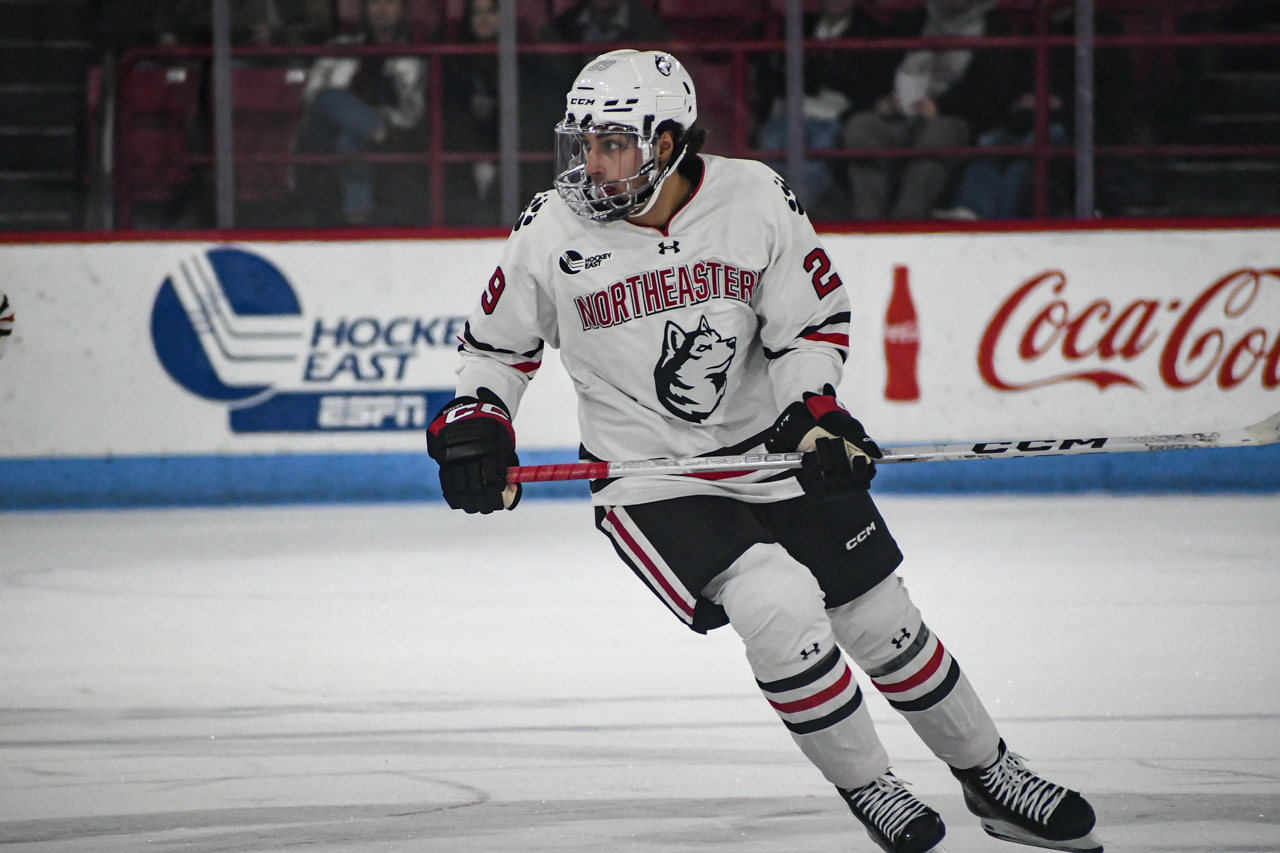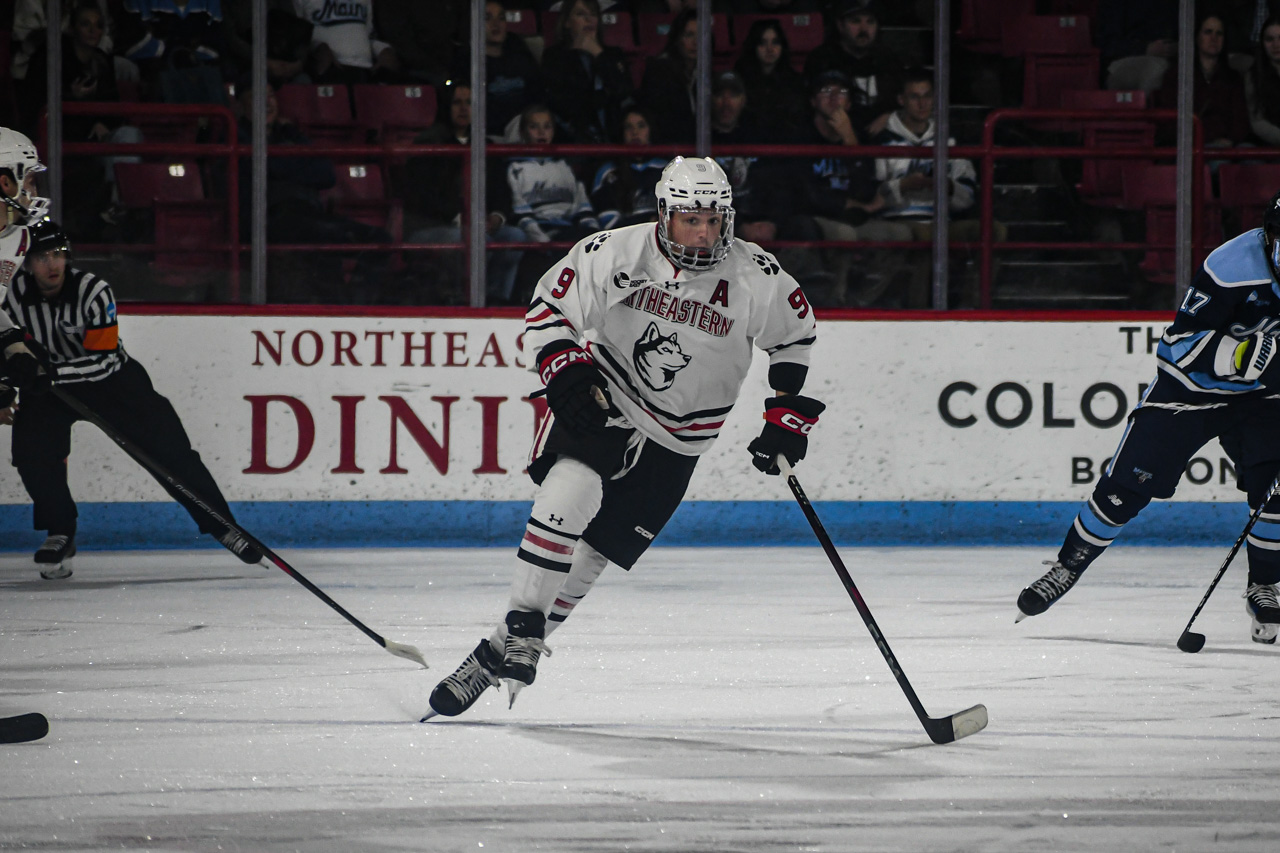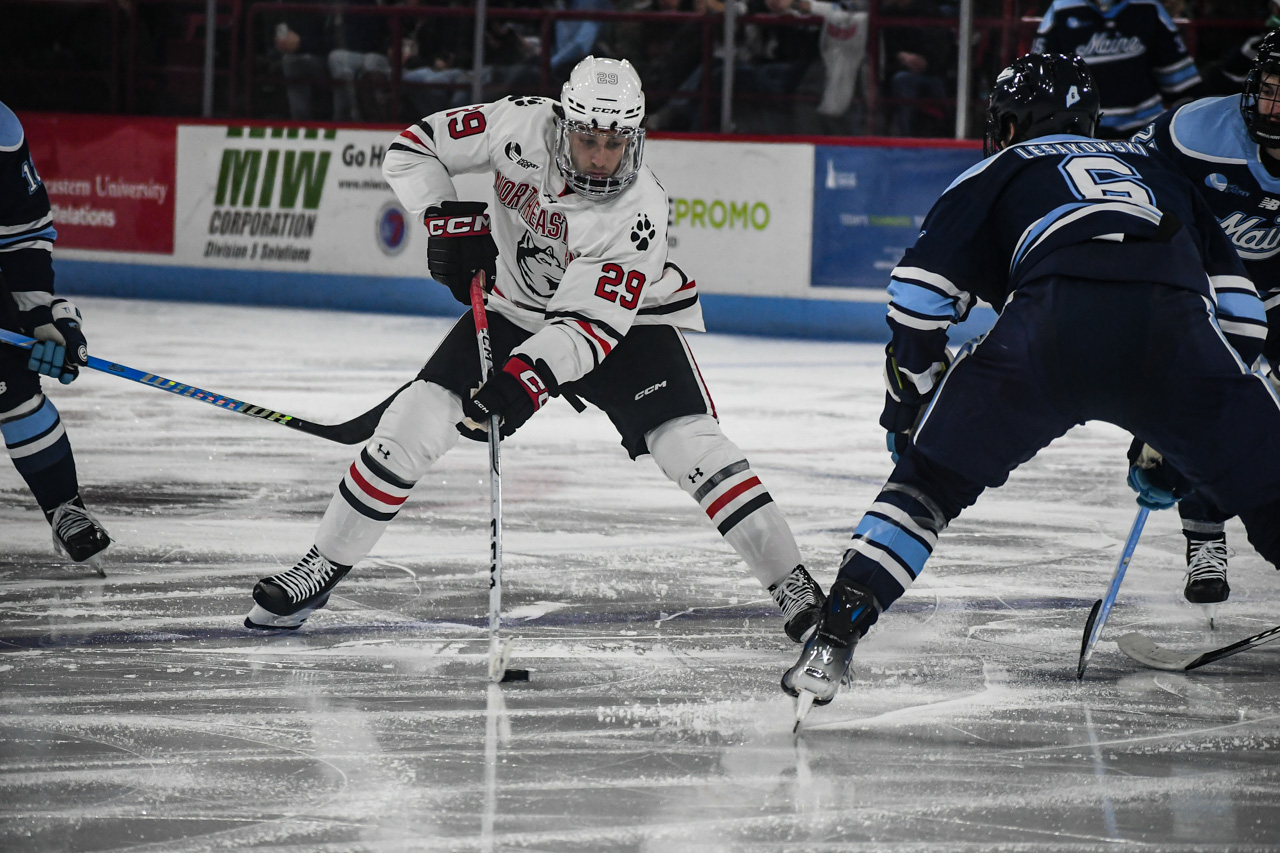
BOSTON — It was the morning of Monday, March 18, less than 48 hours after Northeastern’s season came to a close against Boston University in the Hockey East quarterfinals. For associate head coach Mike Levine, there was no time to dwell.
Instead, the first days of the offseason are among the most hectic periods of the year for Northeastern’s staff. Rather than game planning for the next opponent, Levine would now be spending hours each day watching tape of players around the country, making real-time evaluations of their skills, traits, and potential roster fit. Many more hours would be devoted to phone calls with a vast network of fellow coaches, advisors, agents, and family members.
Levine plays a central role in Northeastern’s efforts to navigate the transfer portal, which has become a rough equivalent of free agency in college hockey. The Huskies have embraced the sport’s new and chaotic method of roster building, adding five transfers last offseason and six more this year — the second-most of any Hockey East school.
“Things happen pretty quickly once players go into the portal. So you have to be ready,” said Levine. “You have to almost start the recruiting process immediately once there is interest.”
The landscape of college athletics has evolved rapidly over the past half-decade, following a series of NCAA rule changes and court decisions which eased restrictions on player movement and enabled athletes to profit off their Name, Image, and Likeness (NIL). In college hockey, the volume of transfers has grown each of the past five years, reaching an all-time high of 312 in the 2024 offseason.
Northeastern was among college hockey’s successful early adoptees of the portal, beginning with Tommy Miller (Michigan State) and Jakov Novak (Bentley) in 2021. Last year, Alex Campbell, a transfer from Clarkson, tallied 22 goals and 42 points in his lone season at Northeastern, the second-highest point total by a Northeastern player in five years.
In 2024, the Huskies have landed another prized class. The group is headlined by Omaha junior defenseman Jo Lemay, Quinnipiac senior wing Christophe Tellier, and Colgate senior center Ryan McGuire, each widely viewed as among the nation’s top portal options at their respective positions. Northeastern also bolstered their blue line depth with Jake Boltmann from Notre Dame and Jake Higgins from Holy Cross, who bring 240 combined games of college experience between them.
“In college hockey today, you have to use the portal. There’s no way around it,” said Northeastern head coach Jerry Keefe. “I think every year is a little bit different depending on how your team is built, but it’s something we want to take advantage of.”
While a select handful of top players receive NIL compensation in college hockey, those interviewed for this story stressed that it’s not a relevant concern — let alone a driving factor — for most transfers, unlike in college football and basketball. Instead, most players’ primary focus is on finding the best program to develop them and earn a professional contract.
And though it sounds straightforward, that matching process is murky and often lacks transparency.
According to Levine, when a player first enters the portal, the player’s agent or advisor often initiates the process by reaching out to programs they identify as a potential fit. In some cases, the prospective transfer or his advisor has a pre-existing relationship with a player or coach at another program, which helps to initiate the process. It’s more rare that coaches locate players in the portal with no prior connection or communication, though it does happen occasionally, especially later in the offseason.
“Once a player goes into the portal, you’re having conversations with their advisors. That’s something that has changed since I started,” Levine said. “Players lean more on the advisors’ opinion than ever before. So having a relationship with an advisor can help or hinder where that player ends up.”
When it comes time for the coaching staff to connect directly with the player and make their pitch, Northeastern’s staff is confident in what they have to offer: A long track record of developing NHL players, the big stage of Hockey East and the Beanpot, a competitive roster, and quality academics in the heart of Boston.

Especially with highly-sought players, the process unfolds quickly. Lemay, a fourth-round draft pick of the Washington Capitals in 2022, officially entered the transfer portal on April 4, just one week after wrapping up his breakout sophomore season at the University of Omaha. Three days later, the defender committed to Northeastern.
When the offseason began, Lemay sat down with the three parties which have the most input on his long-term development — his family, his agent, and the Capitals front office — and compiled a list of priorities. Quickly, Lemay and his support group identified Northeastern as a program that checked all the boxes: A track record of developing professional-caliber defensemen, a featured role on a competitive team, and a school closer to his family in Quebec.
Lemay and his team quickly got in touch with Northeastern’s coaching staff, and both sides raced to conduct their due diligence.
“It all happened so fast, so I had to trust the people who have my best interests,” Lemay said. “For us, it was about digging deep into the coaching staff and how good the team is going to be. And then even deeper than that, the structure around it, like the assistants and the strength coach … It really comes down to asking, ‘are these all hardworking people that want to develop me as badly as my own people want to?’”
Likewise, Christophe Tellier, a key piece of Quinnipiac’s 2023 national title team and one of the country’s top playmakers, entered the portal in search of improving his professional stock in his final season of college eligibility.
Tellier was introduced to Northeastern through Huskies’ captain Jack Williams, who he became friends with while playing together on the Muskegon Lumberjacks (USHL) during the 2020-21 season.
“[Williams] shot me a call right after I entered the portal, and was like, ‘we’d love to have you here,’ and talked about how exciting the team would be,” Tellier said. “So that got me interested at first.”
After Williams’ initial outreach, it was up to Keefe and Levine to sell Tellier on the development opportunities at Northeastern and his fit on the roster — an easier pitch following Campbell’s departure at left wing.
“When I started talking with coaches and stuff, I thought they had great experience, great leadership,” Tellier said. “My goal is obviously to get an NHL contract at the end of the season. And personally, I think after this year getting a bigger role on this team, I think I can make the jump to the pro level.”
Like Tellier, Ryan McGuire had a laundry list of potential suitors following a breakout 14-goal junior season at Colgate. But the Belmont Hill (Mass.) prep school product was intent on playing in the Beanpot, which immediately narrowed his options and put Northeastern in the conversation.
McGuire, a two-way center and one of the nation’s top faceoff takers, was a natural fit to take over the center role held by last year’s team captain Justin Hryckowian, who departed for the Dallas Stars.
“Once the season was done, I spoke a little bit to my agent about the decision to maybe move on past Colgate, and I told him I wanted to focus on a Beanpot school,” McGuire said. “So when I entered the portal, Northeastern called me pretty quick and we got in touch.”
Beyond filling a clear roster need, the external connections also added up for McGuire. Keefe had a ringing endorsement from McGuire’s father, longtime NHL broadcaster and executive Pierre McGuire. He also skated over the previous summer with Owen Keefe, Jerry’s son and a Northeastern commit.
“My dad told me that Coach Keefe, you really can trust him. He said he’s one of the best coaches he knows in college hockey,” McGuire said. “And so knowing that, and then seeing the development they’ve had with guys like Devon Levi and others, I just knew this was a place who cares about developing their players and also wins.”
Lemay echoed the importance of the Beanpot, which puts a national spotlight on Northeastern’s program each year and particularly resonates with players who grew up locally. It doesn’t hurt that Northeastern has won the title five of the past six seasons.
“I remember I was in my house last year in Omaha, watching the Beanpot, like ‘damn, this is sick.’ So I think that helped a lot,” Lemay said.

As Keefe views it, the successful outcomes of previous transfers is a key component of the Huskies’ sales pitch for prospective additions. Keefe highlighted defenseman Tommy Miller, who earned a contract with AHL’s Toronto Marlies after his successful 2021-22 season at Northeastern, as a roadmap for other veteran defenseman in the portal.
“I think your track record speaks for itself,” Keefe said. “You want the players to see that they transferred into Northeastern and they’ve had a great experience, and now they can do the same.”
In the end, the goal for Keefe and his program is to achieve sustainable success — an objective which still begins with recruiting freshmen and developing homegrown talent. But with Northeastern’s continued success navigating the transfer portal, using both avenues simultaneously has become critical towards fielding a competitive roster.
“We want to make sure we are bringing in the right blend of younger guys that were talented as freshmen, but also some older guys that can replace what we lose,” Keefe said. “But to go out and identify really good players that have played in great programs and were big parts of their team’s success, that helps.”

